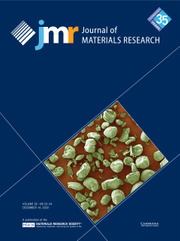Crossref Citations
This article has been cited by the following publications. This list is generated based on data provided by
Crossref.
Roldán, M.
Fernández, P.
Rams, J.
Jiménez-Rey, D.
Ortiz, C.J.
and
Vila, R.
2014.
Effect of helium implantation on mechanical properties of EUROFER97 evaluated by nanoindentation.
Journal of Nuclear Materials,
Vol. 448,
Issue. 1-3,
p.
301.
Roldán, M.
Fernández, P.
Rams, J.
Jiménez-Rey, D.
Materna-Morris, E.
and
Klimenkov, M.
2015.
Comparative study of helium effects on EU-ODS EUROFER and EUROFER97 by nanoindentation and TEM.
Journal of Nuclear Materials,
Vol. 460,
Issue. ,
p.
226.
Xu, Y
Balint, D S
and
Dini, D
2016.
A method of coupling discrete dislocation plasticity to the crystal plasticity finite element method.
Modelling and Simulation in Materials Science and Engineering,
Vol. 24,
Issue. 4,
p.
045007.
Mohammed, Yousuf S.
Baumgart, Helmut
and
Elmustafa, A. A.
2017.
Mechanical/Structural Properties of Ag, Cu, and Ni Thin Films.
ECS Journal of Solid State Science and Technology,
Vol. 6,
Issue. 5,
p.
P253.
Wang, Yuxin
Cheng, Guang
Tay, See Leng
Guo, Yunxia
Sun, Xin
and
Gao, Wei
2017.
Effects of Bi Addition on the Microstructure and Mechanical Properties of Nanocrystalline Ag Coatings.
Materials,
Vol. 10,
Issue. 8,
p.
932.
Cheng, Guang
Sun, Xin
Wang, Yuxin
Tay, See Leng
and
Gao, Wei
2017.
Nanoindentation study of electrodeposited Ag thin coating: An inverse calculation of anisotropic elastic-plastic properties.
Surface and Coatings Technology,
Vol. 310,
Issue. ,
p.
43.
Stegall, D. E.
and
Elmustafa, A. A.
2018.
The Contribution of Dislocation Density and Velocity to the Strain Rate and Size Effect Using Transient Indentation Methods and Activation Volume Analysis.
Metallurgical and Materials Transactions A,
Vol. 49,
Issue. 10,
p.
4649.
Sun, Changquan Calvin
2018.
Pharmaceutical Crystals.
p.
273.
Xu, Y.
Balint, D.S.
and
Dini, D.
2019.
A new hardness formula incorporating the effect of source density on indentation response: A discrete dislocation plasticity analysis.
Surface and Coatings Technology,
Vol. 374,
Issue. ,
p.
763.
Mohammed, Y. S.
Stone, D. S.
and
Elmustafa, A. A.
2019.
Strain Rate Sensitivity of the Nanoindentation Creep of Ag, Cu, and Ni Thin Films.
JOM,
Vol. 71,
Issue. 10,
p.
3734.
Stan, Gheorghe
and
King, Sean W.
2020.
Atomic force microscopy for nanoscale mechanical property characterization.
Journal of Vacuum Science & Technology B,
Vol. 38,
Issue. 6,
Wang, Jin
Volz, Tillmann
Weygand, Sabine M.
and
Schwaiger, Ruth
2021.
The indentation size effect of single-crystalline tungsten revisited.
Journal of Materials Research,
Vol. 36,
Issue. 11,
p.
2166.
Yu, Zhijie
Lin, Zhongya
and
Wei, Yueguang
2021.
Investigation on cross-scale indentation scaling relationships of elastic–plastic solids.
Acta Mechanica,
Vol. 232,
Issue. 4,
p.
1479.
Yu, Zhijie
Lin, Zhongya
and
Wei, Yueguang
2021.
Closed-form functions of cross-scale indentation scaling relationships based on a strain gradient plasticity theory.
Philosophical Magazine,
Vol. 101,
Issue. 11,
p.
1305.
Allen, Evan M.
Moradi, Marzyeh
and
Maughan, Michael R.
2021.
Reducing indentation size effect in metals by load function selection.
Journal of Materials Research,
Vol. 36,
Issue. 14,
p.
2915.
Ji, Xinkuo
Xiao, Gesheng
Zhao, Wei
Lv, Pin
Zhao, Yuxiang
Jin, Xiaochao
and
Fan, Xueling
2022.
Loading rate sensitivity of nickel-based single crystal superalloys characterized by nanoindentation.
International Journal of Solids and Structures,
Vol. 234-235,
Issue. ,
p.
111272.
Gargalis, Leonidas
Karavias, Leonidas
Graff, Joachim S.
Diplas, Spyros
Koumoulos, Elias P.
and
Karaxi, Evangelia K.
2023.
Novel Powder Feedstock towards Microstructure Engineering in Laser Powder Bed Fusion: A Case Study on Duplex/Super Duplex and Austenitic Stainless-Steel Alloys.
Metals,
Vol. 13,
Issue. 9,
p.
1546.
Si, Bowen
Li, Zhiqiang
Yang, Xuexia
Shu, Xuefeng
and
Xiao, Gesheng
2023.
Characterizations of specific mechanical behaviors for metallic materials with representative crystal structures using nanoindentation.
Vacuum,
Vol. 207,
Issue. ,
p.
111661.
Ojha, M.
Al-Allaq, A. H.
Mohammed, Y. S.
Bhukya, S. N.
Wu, Z.
and
Elmustafa, A. A.
2023.
Elastic properties of the non-mixing copper donor assisted material in friction stir welding of aluminum alloys using nanoindentation.
Frontiers in Metals and Alloys,
Vol. 2,
Issue. ,
Zhou, Diaoyu
Yu, Jiasheng
Dong, Yiwei
Qin, Yalu
and
Hao, Xinwei
2024.
Indentation of Commercial Pure Titanium Processed by Cold Rolling.
Metals,
Vol. 14,
Issue. 3,
p.
327.


